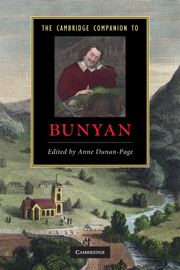Book contents
- Frontmatter
- Introduction
- Part I John Bunyan in his seventeenth-century context
- Part II John Bunyan’s major works
- Part III Readership and reception
- 10 Posthumous Bunyan: early lives and the development of the canon
- 11 The Victorians and Bunyan’s legacy
- 12 Bunyan: colonial, postcolonial
- Guide to further reading
- Index
11 - The Victorians and Bunyan’s legacy
from Part III - Readership and reception
Published online by Cambridge University Press: 28 July 2010
- Frontmatter
- Introduction
- Part I John Bunyan in his seventeenth-century context
- Part II John Bunyan’s major works
- Part III Readership and reception
- 10 Posthumous Bunyan: early lives and the development of the canon
- 11 The Victorians and Bunyan’s legacy
- 12 Bunyan: colonial, postcolonial
- Guide to further reading
- Index
Summary
Little Nell's journey out of London into the Midlands in The Old Curiosity Shop (1841) might easily be read as a progress from the Slough of Despond into the Celestial City. Accompanied by her grandfather, Nelly Trent cheerfully engages on her pilgrimage, her path illuminated by the 'full glory of the sun' and decorated by scores of new-build churches, 'erected with a little superfluous wealth, to show the way to Heaven'. Forging her way through 'the haunts of commerce and great traffic' (symbols that, if granted capital letters, would be happy in the company of Bunyan's Talkative or Giant Despair), Nell arrives at Dickens's rendering of the Wicket Gate, a turnpike framed in a pastoral setting. From here, the narrator claims “the traveller might stop, and - looking back at old Saint Paul's looming through the smoke, its cross peeping above the cloud (if the day were clear), and glittering in the sun; and casting his eyes upon the Babel out of which it grew until he traced it down to the furthest outposts of the invading army of bricks and mortar whose station lay for the present nearly at his feet - might feel at last that he was clear of London.”
- Type
- Chapter
- Information
- The Cambridge Companion to Bunyan , pp. 150 - 161Publisher: Cambridge University PressPrint publication year: 2010
- 3
- Cited by

